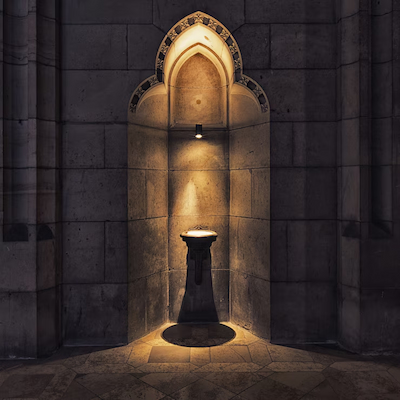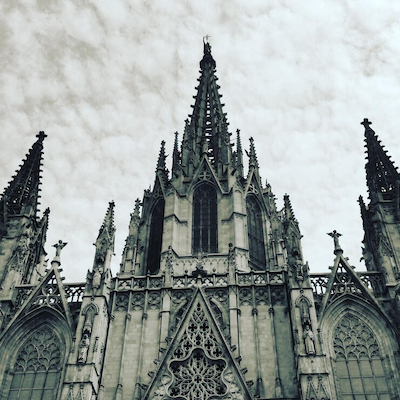
Gothic architecture is a style that emerged in Europe during the Middle Ages, approximately between the 12th and 16th centuries. Characterized by its towering structures and intricate details, this architectural style stood out for its ability to create spaces that not only served functional purposes but also conveyed spiritual and symbolic messages. Gothic cathedrals, in particular, became icons of this aesthetic, reflecting humanity’s desire to connect with the divine through art and architecture.
Technical innovations of the time—such as pointed arches, flying buttresses, and colorful stained-glass windows—allowed Gothic architects to push beyond the limitations of Romanesque architecture. These innovations enabled the creation of buildings that soared toward the heavens, adorned with intricate details that told biblical stories and embodied the worldview of the era. In this article, we will explore how Gothic cathedrals function, the advantages of this architectural style, and how it transforms spaces with its bold structural elements.
How Gothic Cathedrals Work: Bold Structure and Spiritual Symbolism
Gothic cathedrals are masterpieces of both engineering and art, functioning through a combination of innovative architectural techniques. One of the most defining elements is the pointed arch, which distributes weight more efficiently than the rounded arches used in Romanesque design. This innovation allowed for taller and thinner walls, creating the verticality and lightness that characterize Gothic architecture.
Another key element is the use of flying buttresses—external supports that stabilize the walls and bear the pressure from high ceilings. These structures not only serve a structural purpose but also become aesthetic features that enhance the cathedral’s façade. The combination of pointed arches and buttresses allowed cathedrals to reach impressive heights, creating vast, luminous interiors.
Stained-glass windows are another essential component, functioning as both decorative and lighting elements. Often depicting biblical scenes and saints, these windows filter natural light, creating a mystical and spiritual atmosphere inside the cathedral. As light passes through, it casts vibrant colors onto the walls and floors, transforming the space into a visual spectacle that enhances spiritual experience.
Finally, symmetry and proportion are crucial in the design of Gothic cathedrals. Every element—from the towers to the portals and sculptures—is carefully planned to create visual harmony that draws the eye and guides visitors through the space. This attention to detail and aesthetics is not just about beauty—it reflects the desire to represent divine order in the material world.

Advantages of Gothic Architecture: Bold Structure and Spiritual Symbolism
Gothic architecture offers numerous advantages that make it a revered and admired style even today. One of the main advantages is its ability to create spacious and well-lit interiors. The use of pointed arches and flying buttresses allows for large windows, often filled with stained glass. This results in interiors that are not only visually striking but also evoke a sense of openness and freedom, contrasting with the heavier, darker Romanesque structures.
In addition, Gothic architecture is known for its durability and strength. The building techniques—such as stone construction and external supports—ensure that these structures withstand the test of time. Many Gothic cathedrals, like Notre-Dame in Paris and Chartres Cathedral, remain cultural and architectural landmarks that attract millions of visitors each year. Their enduring presence is a testament to the skill and knowledge of medieval builders.
Another major advantage of Gothic architecture is its storytelling power through art. Gothic cathedrals are richly decorated with sculptures, reliefs, and stained glass that illustrate religious and historical narratives. These elements do more than adorn the building—they educate visitors about Christian history and medieval culture. The integration of art and spirituality is a defining feature of this style, one that continues to inspire artists and architects today.
Lastly, Gothic architecture offers a unique spiritual experience. These cathedrals were designed to inspire awe and reverence. The height of the nave, the light through stained glass, and the complexity of the details create an environment that encourages contemplation and reflection. For many, visiting a Gothic cathedral is more than an aesthetic experience—it is a spiritual journey that connects the individual with something greater.
How Gothic Architecture Transforms Spaces with Bold Structures
-
The use of pointed arches to support great heights: Pointed arches are fundamental to Gothic architecture, allowing cathedrals to reach impressive heights while effectively distributing weight. This technique ensures stability and creates a striking visual effect for visitors.
-
The importance of stained-glass windows for interior light: These windows are more than decorative—they play a vital role in illuminating the cathedral interior. The light passing through creates a magical, spiritual ambiance that transforms the space.
-
The role of tall towers in cathedral aesthetics: Towering spires symbolize ambition and the search for God. These architectural features are not only city landmarks but also expressions of humanity’s desire to reach the divine.
-
The presence of sculpted gargoyles as decorative elements: Gargoyles are not just visually intriguing—they serve a practical purpose by diverting rainwater away from the cathedral walls. Their grotesque forms add mystery and fascination to the architecture.
-
The creation of vertical spaces that impress visitors: The verticality of Gothic cathedrals instills a sense of grandeur and elevation. Visitors are drawn to look upward, marveling at vaulted ceilings and the detailed artwork above.
-
The combination of decorative elements that enrich the architecture: Gothic design is rich with ornamental details—from sculptures to reliefs depicting religious figures and stories. This fusion of decorative elements enhances the visual and spiritual experience, making each cathedral unique and unforgettable.
Gothic architecture transforms spaces in ways that go far beyond aesthetics. It creates environments that inspire and elevate, inviting visitors to explore not only the beauty of the structures but also the spiritual depth they embody. Each Gothic cathedral stands as a testament to human creativity and the search for transcendence—a space where art and spirituality meet.

Did You Enjoy Learning About Gothic Architecture: Bold Structure and Spiritual Symbolism?
Gothic architecture is a fascinating and timeless subject that reveals profound insights into the culture, spirituality, and ingenuity of the Middle Ages. More than just buildings, Gothic cathedrals are monumental expressions of faith, artistic ambition, and communal identity. Each structure tells a unique story—etched in stone, light, and space—about the people who conceived, built, and worshipped within them.
These cathedrals stand as awe-inspiring achievements of engineering and art, embodying a deep connection between the earthly and the divine. Through soaring arches, radiant stained glass, and meticulously carved details, they evoke a sense of transcendence that continues to captivate visitors across generations. Their enduring presence in the urban landscapes of Europe and beyond is a testament to the vision and craftsmanship of medieval architects and artisans, whose legacy still shapes how we understand space, light, and sacred beauty.
If this topic sparked your interest, know that you’ve only scratched the surface. Gothic architecture is a vast and richly layered field that invites continuous discovery. From the symbolic meanings of architectural elements to the stories behind famous cathedrals, from regional variations to the restoration efforts that preserve these masterpieces today—there is always more to explore. Dive into historical texts, architectural analyses, virtual tours, or even travel to experience these wonders in person.
Frequently Asked Questions
What is Gothic architecture?
Gothic architecture is a style that originated in Europe between the 12th and 16th centuries. It’s known for its pointed arches, colorful stained glass, and grand cathedrals.
What are the main characteristics of Gothic architecture?
The main features include pointed arches, ribbed vaults, and flying buttresses. These elements provide both support and beauty to breathtaking structures.
How does Gothic architecture represent spiritual symbolism?
Gothic architecture: bold structure and spiritual symbolism is designed to make us look upward. The soaring heights of cathedrals symbolize a connection to the divine.
What are some famous examples of Gothic architecture?
Cathedrals like Notre-Dame in Paris and Cologne Cathedral in Germany are famous examples. They showcase the grandeur of Gothic style.
Where can I learn more about Gothic architecture?
You can visit museums, explore websites on art and architecture, or even take online courses. Gothic architecture is full of history and beauty!

